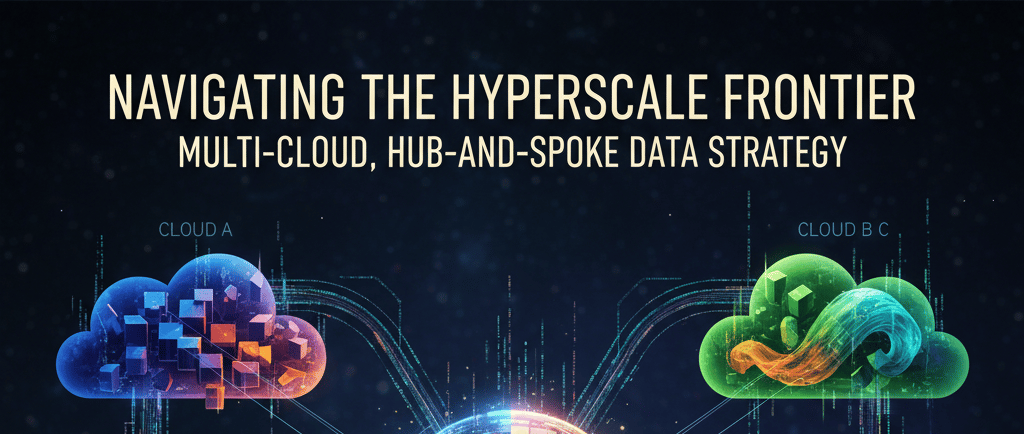Navigating the Hyperscale Frontier: Why a Multi-Cloud, Hub-and-Spoke Strategy is Your North Star
Bryon Spahn
9/16/20253 min read


In today's data-driven world, the cloud is no longer just an option – it's the bedrock of innovation and competitive advantage. For CIOs and technology leaders, the sheer scale and complexity of managing data across hyperscale cloud platforms can feel like navigating uncharted waters. The promise of agility, scalability, and cost efficiency is immense, but so too are the potential pitfalls of vendor lock-in and fragmented data estates.
At Axial ARC, we believe the path to truly unlock the power of hyperscale cloud lies not in committing to a single provider, but in strategically orchestrating a multi-cloud, hub-and-spoke data platform. This approach offers a robust framework for organizations to thrive in an increasingly distributed and data-intensive landscape.
The Allure of Hyperscale: A Double-Edged Sword
Hyperscale cloud providers offer unparalleled computational power and storage capabilities. From advanced analytics and machine learning to global application deployment, their services are transformative. However, relying solely on one provider can introduce significant challenges:
Vendor Lock-in: Migrating data and applications from one hyperscale cloud to another can be a costly, time-consuming, and technically arduous endeavor. This lack of portability can stifle innovation and limit your strategic options.
Regional Specialization: Different cloud providers excel in different areas or have stronger presences in specific geographies. A single-cloud strategy might force compromises on performance, compliance, or access to specialized services.
Resilience and Disaster Recovery: While individual cloud providers offer robust uptime, a multi-cloud approach can further enhance resilience, providing failover options across entirely independent infrastructures.
The Hub-and-Spoke Advantage: Centralized Control, Distributed Power
This is where the multi-cloud, hub-and-spoke strategy shines. Imagine a central "hub" – a unified data platform – that acts as the authoritative source and control plane for your enterprise data. This hub is then connected to various "spokes," which are your specific workloads and applications residing in different hyperscale cloud environments.
Here's why this model is a game-changer for CIOs and technology leaders:
Optimized Cloud Utilization: Deploy workloads to the cloud platform that best meets its specific requirements for performance, cost, compliance, or specialized services. This ensures you're always getting the right tool for the job.
Enhanced Data Governance and Security: With a central hub, you can enforce consistent data governance policies, security protocols, and access controls across your entire data landscape, regardless of where the data physically resides.
Improved Data Portability and Resilience: Your central hub acts as a single source of truth, making it easier to move data between cloud providers if business needs change, or to recover data in the event of an outage in a specific cloud.
Cost Optimization: By strategically placing workloads, you can leverage competitive pricing models and avoid being locked into a single provider's cost structure. This allows for greater negotiation power and smarter budgeting.
Accelerated Innovation: Your teams gain the flexibility to experiment with new services and technologies offered by various cloud providers without having to re-architect their entire data foundation.
The Imperative of Open Data Standards
A multi-cloud, hub-and-spoke strategy, however, is only as effective as its underlying data interoperability. This is where the commitment to open data standards becomes paramount.
Without open standards, your central hub risks becoming another form of lock-in, albeit a different one. By aligning with open data formats, APIs, and protocols, you ensure that:
Data Portability is Genuine: Data created and processed in any "spoke" cloud can be seamlessly integrated, maintained, and leveraged within your central repository. This eliminates the need for complex, proprietary conversions and reduces data silos.
Future-Proofing Your Investment: As new cloud technologies emerge or your business needs evolve, adhering to open standards ensures your data platform remains adaptable and capable of integrating with future innovations.
Empowering Data Scientists and Analysts: With standardized data formats, your data teams can work with consistent, reliable data irrespective of its origin, fostering greater collaboration and accelerating insights.
Partnering with Axial ARC: Bringing Your Vision to Life
At Axial ARC, we specialize in designing, implementing, and managing sophisticated multi-cloud, hub-and-spoke data platforms. We understand the unique challenges and opportunities faced by CIOs and technology leaders in the hyperscale era. Our expertise lies in:
Strategic Cloud Advisory: Helping you identify the optimal cloud platforms for your specific workloads and architect a robust hub-and-spoke model.
Open Data Standards Implementation: Guiding you in adopting and enforcing open data standards to maximize interoperability and prevent vendor lock-in.
Data Governance and Security Frameworks: Building a secure and compliant data environment that transcends individual cloud boundaries.
Seamless Integration and Migration: Ensuring a smooth transition to your new data platform with minimal disruption to your operations.
The future of enterprise data is distributed, intelligent, and highly interconnected. Don't let the complexity of hyperscale cloud dilute its potential. Embrace a multi-cloud, hub-and-spoke strategy, underpinned by open data standards, and position your organization for unparalleled success.
Ready to explore how Axial ARC can help you architect your multi-cloud data future? Contact us today for a consultation.
